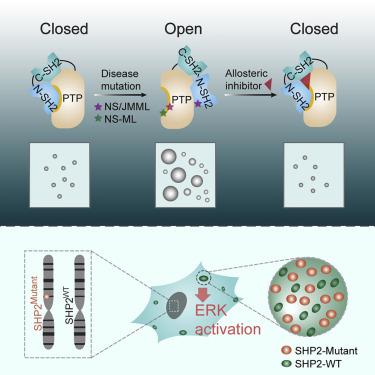Cell ( IF 45.5 ) Pub Date : 2020-09-30 , DOI: 10.1016/j.cell.2020.09.002 Guangya Zhu 1 , Jingjing Xie 1 , Wenna Kong 1 , Jingfei Xie 1 , Yichen Li 2 , Lin Du 3 , Qiangang Zheng 3 , Lin Sun 4 , Mingfeng Guan 1 , Huan Li 1 , Tianxin Zhu 1 , Hao He 1 , Zhenying Liu 1 , Xi Xia 4 , Chen Kan 5 , Youqi Tao 2 , Hong C Shen 6 , Dan Li 2 , Siying Wang 5 , Yongguo Yu 7 , Zhi-Hong Yu 8 , Zhong-Yin Zhang 8 , Cong Liu 4 , Jidong Zhu 9

|
The non-receptor protein tyrosine phosphatase (PTP) SHP2, encoded by PTPN11, plays an essential role in RAS-mitogen-activated protein kinase (MAPK) signaling during normal development. It has been perplexing as to why both enzymatically activating and inactivating mutations in PTPN11 result in human developmental disorders with overlapping clinical manifestations. Here, we uncover a common liquid-liquid phase separation (LLPS) behavior shared by these disease-associated SHP2 mutants. SHP2 LLPS is mediated by the conserved well-folded PTP domain through multivalent electrostatic interactions and regulated by an intrinsic autoinhibitory mechanism through conformational changes. SHP2 allosteric inhibitors can attenuate LLPS of SHP2 mutants, which boosts SHP2 PTP activity. Moreover, disease-associated SHP2 mutants can recruit and activate wild-type (WT) SHP2 in LLPS to promote MAPK activation. These results not only suggest that LLPS serves as a gain-of-function mechanism involved in the pathogenesis of SHP2-associated human diseases but also provide evidence that PTP may be regulated by LLPS that can be therapeutically targeted.
中文翻译:

疾病相关 SHP2 突变体的相分离是 MAPK 过度激活的基础
由PTPN11编码的非受体蛋白酪氨酸磷酸酶 (PTP) SHP2在正常发育过程中的 RAS 丝裂原活化蛋白激酶 (MAPK) 信号传导中起重要作用。令人困惑的是为什么PTPN11 中的酶激活和失活突变导致具有重叠临床表现的人类发育障碍。在这里,我们发现了这些与疾病相关的 SHP2 突变体共有的常见液液相分离 (LLPS) 行为。SHP2 LLPS 由保守的折叠良好的 PTP 结构域通过多价静电相互作用介导,并通过构象变化由内在的自身抑制机制调节。SHP2 变构抑制剂可以减弱 SHP2 突变体的 LLPS,从而增强 SHP2 PTP 活性。此外,疾病相关的 SHP2 突变体可以招募和激活 LLPS 中的野生型 (WT) SHP2 以促进 MAPK 激活。这些结果不仅表明 LLPS 是一种参与 SHP2 相关人类疾病发病机制的功能获得机制,而且还提供了证据表明 PTP 可能受 LLPS 调节,从而成为治疗靶点。











































 京公网安备 11010802027423号
京公网安备 11010802027423号